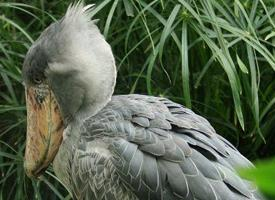
Poids et mesures
| Hauteur au garrot | 1,2 m |
|---|---|
| Poids | 5,6 kg |
| Envergure des ailes | 2,33 m |
Données biologiques
| Durée de vie | 36 r |
|---|
Statut de conservation
| Menacé |
Description de l'animal
The Shoebill (Balaeniceps rex), also known as the whalehead, whale-headed stork, or shoe-billed stork, is a large, prehistoric-looking bird that dwells in the marshes and swamps of tropical East Africa, from Sudan and South Sudan to Zambia. This enigmatic bird, standing up to 5 feet tall with a wingspan reaching between 7.7 to 8.6 feet, is named for its distinctively large, shoe-shaped bill, which can grow up to 9 inches long and 4 inches wide. The bill is not just remarkable in shape but also in function, equipped with sharp edges for decapitating prey, and a hook at the end for handling slippery catches.The Shoebill's plumage is predominantly grey, giving it a statuesque, almost stone-like appearance when it stands motionless for hours, waiting to ambush its prey. This coloration also provides excellent camouflage in its swampy habitats. Its eyes are a striking yellow, set in a face that some find endearing and others slightly unnerving. Despite its stork-like appearance, genetic studies have shown that the Shoebill is more closely related to pelicans and herons.
One of the most fascinating aspects of the Shoebill is its solitary nature. These birds are most often found alone, except during the breeding season. They are territorial and prefer to hunt and live in large, undisturbed wetlands. Their diet primarily consists of fish, notably lungfish, but they also consume amphibians, small reptiles, and even small mammals. The Shoebill utilizes a patient hunting strategy, standing still for long periods before striking with lightning speed to snatch its prey.
Breeding pairs of Shoebills are not only rare but also exhibit unique behaviors. They build large nests on floating vegetation, where they lay one to three eggs. Both parents take part in incubating the eggs and feeding the chicks. The survival rate of the offspring, however, is low, with typically only one chick surviving to fledging. This low reproductive rate, combined with habitat destruction and other human pressures, contributes to the Shoebill's status as a vulnerable species.
Conservation efforts are in place to protect the Shoebill and its habitat, including the designation of protected areas and the implementation of breeding programs. However, the species still faces significant threats from habitat destruction due to agricultural expansion, the pet trade, and climate change, which affects the hydrology of their wetland habitats.
In conclusion, the Shoebill (Balaeniceps rex) is a remarkable bird, not just for its distinctive appearance but also for its unique behaviors and ecological niche. Its presence in the wetlands of East Africa is a testament to the diversity and complexity of these ecosystems. As efforts continue to protect this extraordinary species, the Shoebill remains a symbol of the wild, unexplored corners of our world and a reminder of the importance of conservation.
Nouvelles photos d'animaux
Top 10 des animaux
- Dolphin gull (Leucophaeus scoresbii)
- Diana monkey (Cercopithecus diana)
- Moustached guenon (Cercopithecus cephus)
- Galápagos tortoise (Geochelone nigra complex)
- Russian tortoise (Testudo horsfieldii)
- Japanese macaque (Macaca fuscata)
- Stone loach (Barbatula barbatula)
- Greek tortoise (Testudo graeca)
- Common flying dragon (Draco volans)
- Colossal squid (Mesonychoteuthis hamiltoni)